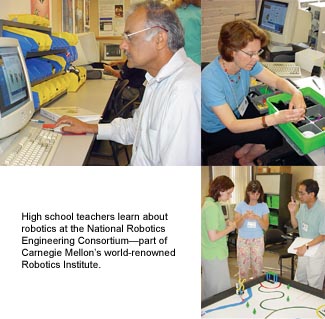Move over, reading, ’riting and ’rithmetic. A new ‘R’ is ready to enter the classroom: robotics!

Researchers at the National Robotics Engineering Consortium (NREC) in Pittsburgh—part of Carnegie Mellon’s world-renowned Robotics Institute—are teaching high school teachers about robotics. In turn, the teachers take the lessons back to the classroom for their own students.
Teachers and students alike report great success when robotics lessons are incorporated into the curriculum. In traditional math and science courses, the addition of robotics makes the subject matter more interesting and gives teachers another way to present required lessons. In engineering and design classes meanwhile, robotics lessons introduce a new field where students can apply their talents.
For others, the exposure to robots prepares them to enter a workforce where they are increasingly likely to encounter mechanized coworkers. While traditional blue-color manufacturing jobs are on the decline, many manufacturers are actively seeking robotics engineers and technicians, according to Robin Shoop, director of educational outreach for NREC.
According to an article published last summer in the Pittsburgh Tribune-Review, robotics lessons at McKeesport Area High School and Technology Center inspired half a dozen students to want to go to college so they could continue to focus on this area. Previously these same students had not expressed much interest in continuing their education beyond high school. It’s that leap from indifferent to eager that has so many teachers excited about incorporating robotics into their everyday lessons.
It all starts with the hands-on workshops for teachers at the vast NREC facility in Lawrenceville. There on the banks of the Allegheny the teachers learn about the current state of robotics research. Then, equipped with LEGO® hardware and Robolab™ software, they get to work building ever more complex robots.
Lessons include adding sensors to robots so they can use the electricity and light around them to become “smarter” about their surroundings. Other instruction focuses on the gears, wheels and pulleys that enable the robot to do its job. Participants program robots to travel precise distances and to perform specific tasks, such as putting a hot dog into a bun.
From these activities emerge academic lessons to take back to the classroom: applied physics, measurements and units, ratios and applied geometry. Not only do the teachers learn how to program and design robots, they also learn how to incorporate robotics into their lessons and present the information clearly. And, of course, they learn how to conduct the same hands-on workshops in their own classrooms, teaching their students the same programming and design skills they learned at NREC.
Related Links:
National Robotics Engineering Consortium
NREC Robotics Academy – Teacher Professional Development
Center for School Outreach



